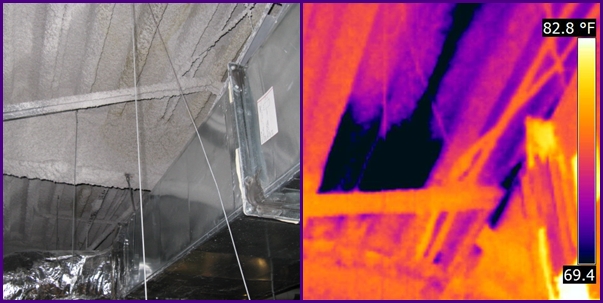Will an IR scan show anything of value when hunting a leak on a ballasted rubber roof, since the ballast rocks tend to hold a bit of water under and around them anyhow?
It would depend on the size or type of Ballast rock. Thick stone ballast roofs are almost imposible for an effective IR scan. However, if the ballast is small pea or pebble size rock, then it should be ok.
The large stone ballast has such a large thermal mass that the wet insulation below doesn’t alter the temp of the stone over the area enough to produce a reliable scan.
Another thing to consider is what type of insulation is under the EPDM roof. If it’s an “Absorbent” type insulation, then you may have better results. But, if is a “Non-absorbent” type insulation, like EPS Foam, than you can forget about it.
There are many other factors as well…
Kevin
Marc,
I would highly recommend removing the ballast, its worthless in my opinion, causes more problems than value…If it was my roof I would get rid of the ballast, and overlay the entire roof, if one leak is beginning you know is occurring, there is probably more than one location which is in need of repair.
Ballast roof coverings are a method of the past…get rid of it…then the leak will be located, or have the entire roof Foamed and don’t even bother looking for the leak, but remove the stone. (Mexicans with shovels work well)—![]()
Marc,
Here is some good information on your particular condition…
http://www.infraredtraining.com/community/boards/thread/2525/
Check for leaks from the inside?
I had a commercial IR scan and that’s exactly what I did…

That wouldn’t really work for a couple reasons. Office areas with dropped ceilings, and the roof deck itself is made of concrete span decks. Right now, I need the ballast. It’s the only thing holding the rubber down. I really don’t know what type of insulation is under the rubber. Nobody’s ever done a core on it, to my knowledge. The ballast is substantially river rock in 2 and 3 inch sizes, about 4 inches deep.
That’s my ???
However, going below is better than above, regardless.
Water seeks it’s lowest level.
Controlled climate indoors cause higher evaporative cooling at leak points.
Ballast that size simply requires removal for testing.
There can be a heard of deer in the woods behind my house.
I can’t see them if leaves block their view.
I can see their foot prints though!
There is direct scan and indirect scan.
Ballast is indirect and must be significant to show up.
Not likely to happen in most situations.
Since “below” is concrete span decks, I don’t know if that would work either. Span decks are hollow concrete “planks”. I guess this roof is simply not a good candidate for thermography for the purposes of locating a leak.
Marc,
Ballasted rubber roofs often have pressed fiberglass or gypsum decks. I do not do thermal imaging but when I worked as an engineering manager I had thermal scans done routinely. I once had a section of a gypsum deck roof collapse while I was waiting for money guys to cut loose some money so I could replace the roof. Gypsum deck is great until it gets wet (they finally approved our request for funds but by then the cost of the job had grown considerably).
Pressed fiberglass in this part of the world typically ranges from an inch and a half to as much as 10". The fiberglass holds water until it reaches saturation. The fiberglass does not absorb the water like a sponge, it holds it in suspension. Very small roof leaks can easily be detected using thermal imaging because of the accumulation of water in spots.
As for the ballast, I agree with Dale’s comments. I don’t know of many new roof installations (at least around here) that use ballast on a rubber roof. It is easier to increase the number of fasteners. Many of my customers have to do things according to FM standards anyway. FM requires more fasteners than most building codes.